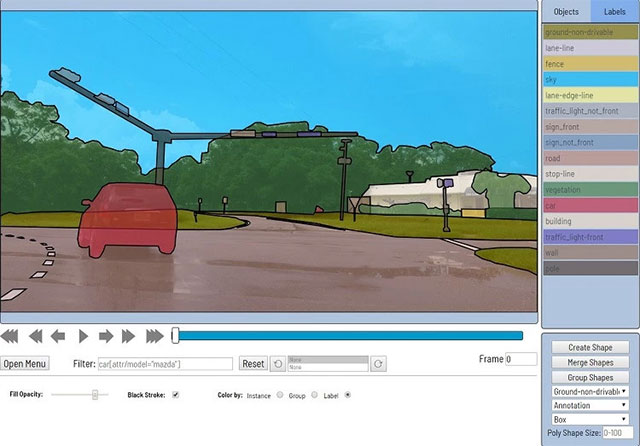Intel CVAT, a handy open source data annotation toolkit
As we know, the training of deep neural networks requires huge amounts of data. In addition, depending on the AI architecture you are holding, that data will not be used repeatedly if it is not labeled, this will take time - especially when you are deploying projects with scale up to hundreds of thousands of objects.
To reduce the burden on data annotation experts as well as data scientists, Intel has released a new program with open source, which is a computer visual annotation tool (Computer Vision Annotation Tool). - CVAT), built to help simplify and expedite the annotation process of video and image samples used to train computer visual algorithms. Intel has announced in their blog post as follows:
'To accelerate the process of annotating data in the Computer Vision field, we have developed a program called CVAT. In general, there are many ways for you to annotate data, but using special tools like CVAT can make this process simpler and faster. "

- Wireshark 3 is officially released, comes with the new Npcap Windows driver
As Santa Clara Data Management Company explained earlier, CVAT will deploy via Docker and be accessed via browser-based interface (or embedded with options on platforms like Onepanel), copper Time to own a task-based management system optimized for specific tasks (users create public tasks to divide work together). In addition, CVAT also supports supervised machine learning tasks related to object detection, image classification, image segmentation and annotation with 1 of 4 types: box, polygon, multi-stroke and multi points.
In CVAT, annotators contain a lot of tools to copy and spread objects, apply filters, adjust visual settings, make annotations automatically, or detect objects through APIs. Google's TensorFlow framework . In addition, CVAT will also perform a number of automated (but not all) tests, and has unique compatibility with data analysis tools like Intel, OpenVino, Nvidia, Cuda and ELK (Elaticsearch, Logstash and Kibana).

- Researchers use computer vision to better understand optical illusion
It can be said that CVAT is a combination of many jobs in a process. Intel notes that this toolkit has only been extensively tested with Chrome, and is not recommended for use with Chrome Sandbox (the "sandbox" feature in Chrome helps limit the environment for processes, including RAM usage and negatively affect the performance of this toolkit). However, Intel also pledged to gradually improve this weakness of CVAT in the future.
'CVAT is built for professional algorithm and annotation development teams, and also receives great support from these people, and we have tried to provide the most useful features. User feedback will help Intel better define the direction for future CVAT development. We hope to soon improve the user experience, feature set, stability, automation features and compatibility with other CVAT services. At the same time, Intel also encourages interested people around the world to actively participate in developing this toolkit. '

- New technology beyond helps sign language barriers
Intel decided to release CVAT only weeks after Uber officially opened its automated visualization system (a web-based platform for media data), and when startups also operate in the field. Data annotations such as Scale and Hive began to increase venture capital and attracted large customers such as Uber and General Motors.
You should read it
- AI uses WiFi data to estimate the number of people in a room
- Cisco Linksys WRT160NL - 'toy' specifically for open source people
- Deep Learning - new cybersecurity tool?
- 5 great open source tools that keep your personal data safe
- 8 best open source NAS operating systems for Linux
- Please download Wifi analyzer application - Wifi Tool, for 30 USD, free of charge
- How to fix the error of not being able to open HandBrake on Windows
- How to Practice Hadoop Online
May be interested
- What is source code? Learn about Source Code
 source code or open source are probably terms you see often, such as open source games or open source software. so what exactly is source code, what is source code, what is open source code and what is closed source code? we will find the answer together through the article below.
source code or open source are probably terms you see often, such as open source games or open source software. so what exactly is source code, what is source code, what is open source code and what is closed source code? we will find the answer together through the article below. - 7 Great open source security apps you may not know yet
 to protect you from increasing online threats, you need to use a variety of security applications. for an ordinary home user, it can be as simple as an antivirus software suite and an anti-malware tool.
to protect you from increasing online threats, you need to use a variety of security applications. for an ordinary home user, it can be as simple as an antivirus software suite and an anti-malware tool. - What is the difference between open source software and closed source software?
 everything you see on the screen includes the language. someone wrote down words for your computer to understand. these words, or languages, are called codes.
everything you see on the screen includes the language. someone wrote down words for your computer to understand. these words, or languages, are called codes. - 10 Best Free Open Source Tools for Students
 while you may need to buy a new laptop or smartphone, paying for software is an expense you can avoid by choosing free and open source alternatives.
while you may need to buy a new laptop or smartphone, paying for software is an expense you can avoid by choosing free and open source alternatives. - Intel Graphics Software Launched: Comprehensive Toolkit for Managing Intel Graphics Cards
 intel calls the new intel graphics software application an 'all-in-one' utility that helps users optimize games, download new graphics drivers, and adjust driver settings on a game-by-game basis.
intel calls the new intel graphics software application an 'all-in-one' utility that helps users optimize games, download new graphics drivers, and adjust driver settings on a game-by-game basis. - 8 best open source NAS operating systems for Linux
 nas (network attached storage) helps troubleshoot data storage and concentration issues in one location. this is where people can access and share data 24/7 via the network.
nas (network attached storage) helps troubleshoot data storage and concentration issues in one location. this is where people can access and share data 24/7 via the network. - 10 Open Source Android Apps You Can't Live Without
 after years of using android phones, many people have become familiar with a number of open source android apps. these apps are better than their closed source counterparts.
after years of using android phones, many people have become familiar with a number of open source android apps. these apps are better than their closed source counterparts. - 10 things to know about open source software
 with the aim of helping open source users stay alert, we think it will be helpful to list some things people should know about open source before using it.
with the aim of helping open source users stay alert, we think it will be helpful to list some things people should know about open source before using it. - 4 Open Source AI Apps You Can Use Every Day
 people have experimented with countless ai tools, but these four great open source tools were chosen because they are easy to use, private, and free.
people have experimented with countless ai tools, but these four great open source tools were chosen because they are easy to use, private, and free. - Warning: The number of vulnerabilities in open source software are increasing rapidly
 besides malware, spam emails or ddos attacks, vulnerabilities in open source software are also considered as one of the most significant security threats at the moment.
besides malware, spam emails or ddos attacks, vulnerabilities in open source software are also considered as one of the most significant security threats at the moment.










 Google launched TensorFlow Lite 1.0 for mobile devices and embedded devices
Google launched TensorFlow Lite 1.0 for mobile devices and embedded devices Google introduced Coral, the platform that supports building AI IoT hardware integration
Google introduced Coral, the platform that supports building AI IoT hardware integration Google launches Backstory - New network security tool for businesses
Google launches Backstory - New network security tool for businesses Nintendo launched the Labo VR kit for Switch
Nintendo launched the Labo VR kit for Switch Chrome for Android owns a super useful desktop feature
Chrome for Android owns a super useful desktop feature Google is preparing to launch a game console, ready to 'battle' the game hardware market
Google is preparing to launch a game console, ready to 'battle' the game hardware market